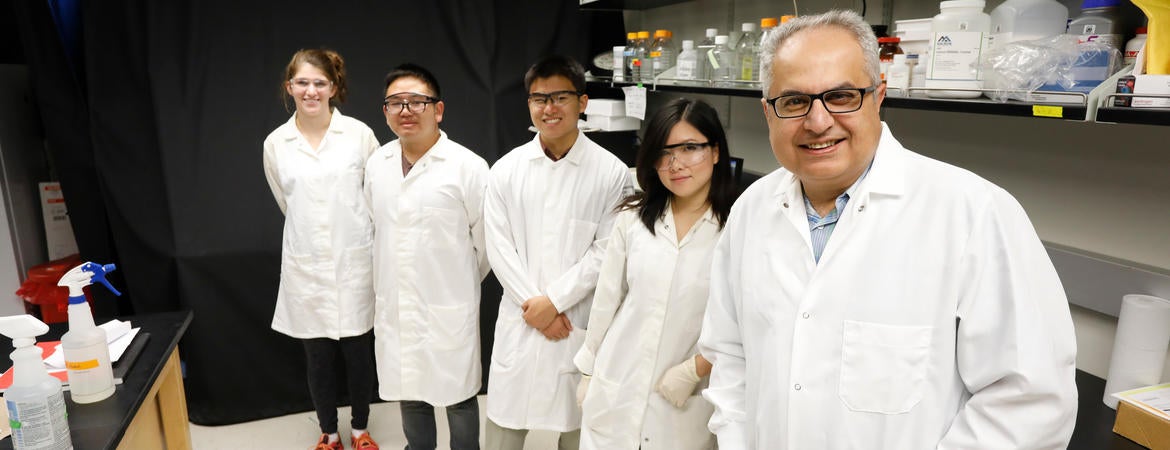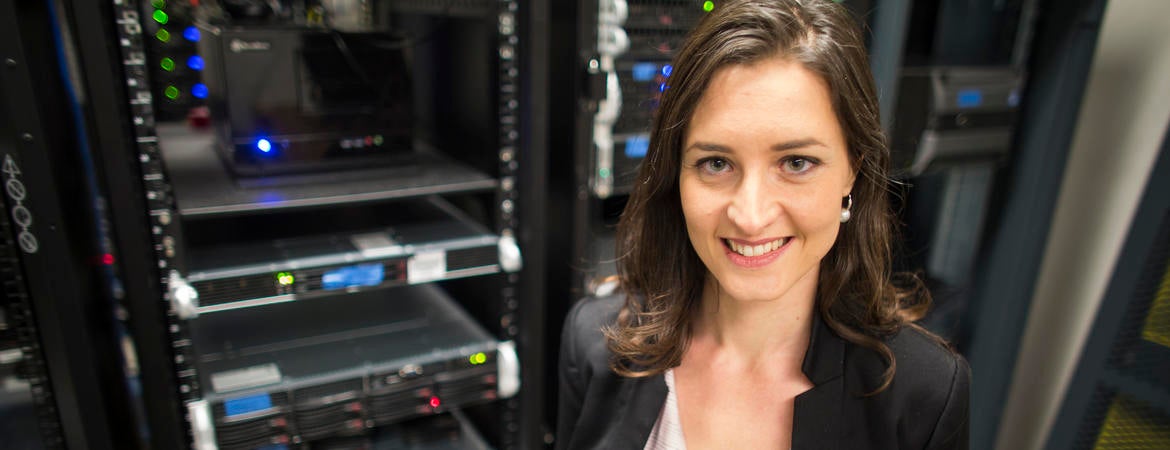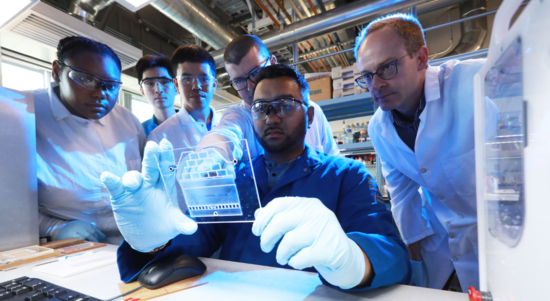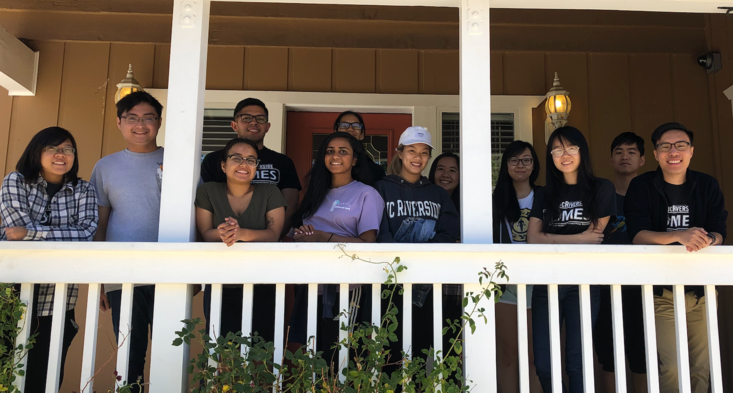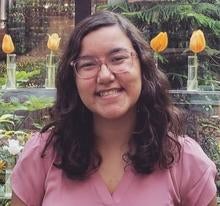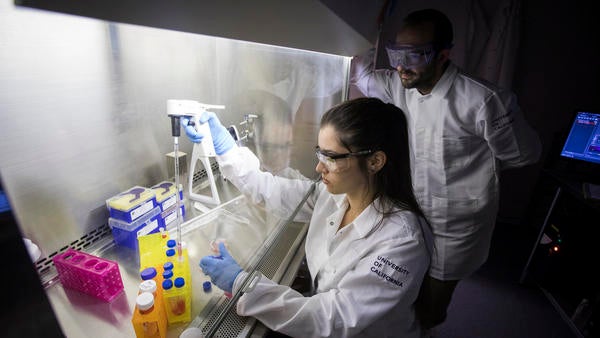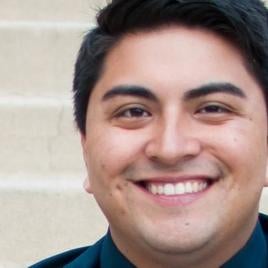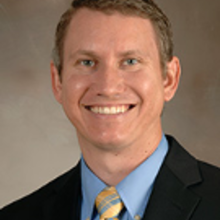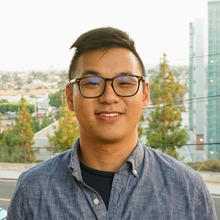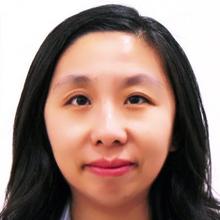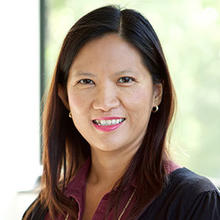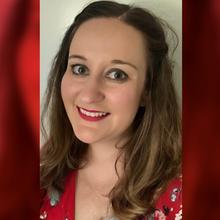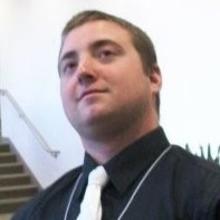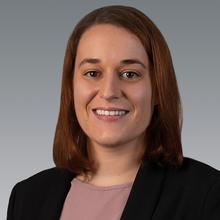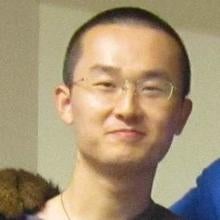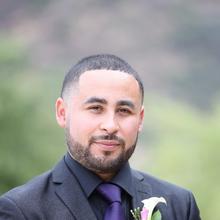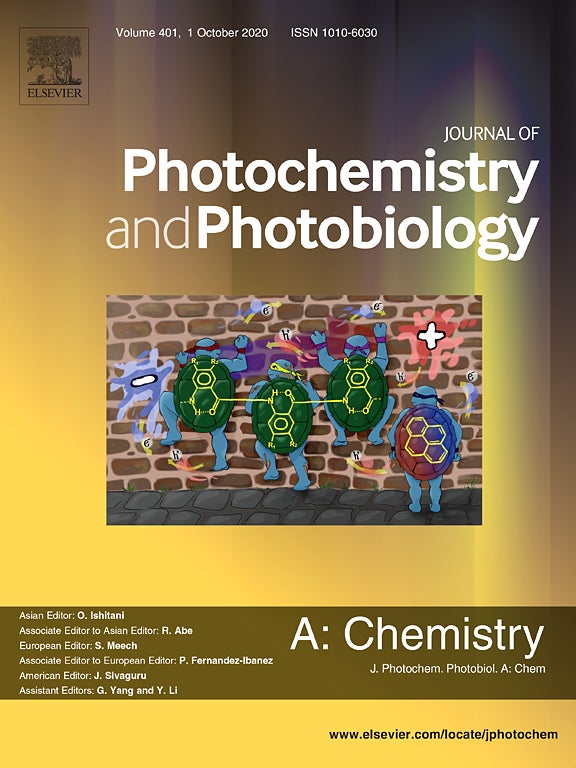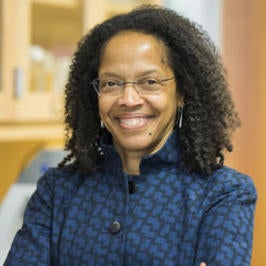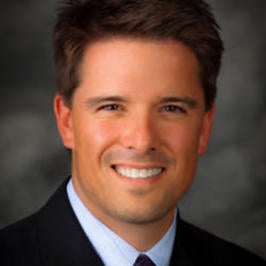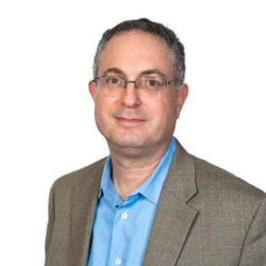Message from the Chair

With the onset of the coronavirus pandemic, 2020 was no doubt a year of challenge, but also one of opportunity for advances in bioengineering and biotechnology. Our Department of Bioengineering in the Marlan and Rosemary Bourns College of Engineering at the University of California, Riverside was well-poised to meet this important moment. Our renowned faculty responded to COVID-19 in real-time with research to better understand and confront this virus, such as using supercomputers to investigate rapid, CRISP-based COVID-19 tests and developing low-temperature plasma technology to sterilize N95 masks for safer reuse by healthcare workers.
This year, our research has been supported by the National Science Foundation, National Institutes of Health, and the Bill and Melinda Gates Foundation among other funding sources. Paired with their research efforts, our faculty have been busy sharing their bioengineering knowledge across the globe at institutions such as Carnegie Mellon University, Columbia University and Peking University in China.
When it comes to our students, our undergraduate and graduate cohorts continue to excel, despite a sudden shift to remote instruction in spring 2020. Our students have emerged top in their ranks and secured prestigious fellowships and scholarships – including a graduate research fellowship from the National Science Foundation. Our ever growing number of alumni, are impacting bioengineering around the world in places like City of Hope, Nova Therapeutics and Dexcom.
Finally, we remember our dear friend and colleague Professor Dimitrios Morikis, who lost his battle with an autoimmune disease in May 2019. At a memorial symposium hosted in his honor, Morikis’ closest colleagues gathered from across the world to celebrate his life’s work.
With our sights set on 2021, we look forward to continuing to offer a rigorous and welcoming bioengineering education and carrying out cutting-edge interdisciplinary research to advance our field.
By the Numbers
5
degrees offered
10
affiliated centers at UCR
11
fellows of professional societies by core faculty
58
graduate students
349
undergraduate students
47%
female undergraduate students
37%
first-generation undergraduate students
27%
international graduate students
$4M +
Research Expenditures
COVID-19 Response
From the onset of the coronavirus pandemic in early 2020, our faculty quickly responded with a series of research endeavors, utilizing our state-of-the-art facilities to develop bioengineering solutions for COVID-19.
- Using supercomputers to investigate rapid, CRISPR-based COVID-19 tests
Assistant Professor Giulia Palermo Read more - Calming influenza’s cytokine storms through selective immune system suppression
Assistant Professor Jiayu Liao Read more - Developing low-temperature plasma technology to sterilize N95 masks for safer reuse
Assistant Professors Joshua Morgan and Justin Charton Read more
Featured Research





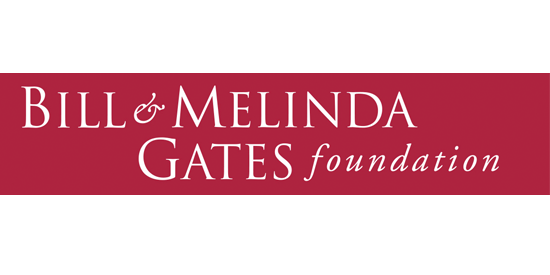
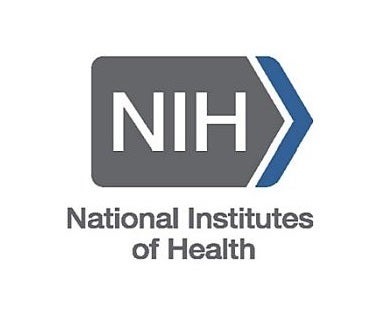

Students
Our rigorous undergraduate educational program is accredited by the Accreditation Board for Engineering and Technology (ABET), well-integrated with research activities, and prepares well-qualified students to become future leaders in bioengineering. Many of our B.S. graduates successfully gain admission into renowned graduate programs, and a number of them have received prestigious awards such as the NSF Graduate Research Fellowship. For those who go into industry, our training prepares them with engineering and biomedical fundamentals and the ability to apply their knowledge to solve real-world problems and quickly translate creative ideas into practical outcomes.
At the graduate level, our education effort is equally excellent. The Bioengineering Interdepartmental Graduate (BIG) Program not only prepares students with a well-rounded academic preparation in engineering and the biosciences for research, but also hones their skills in communicating advanced technical information to an academically diverse audience. Typically, 24% of our eligible doctoral students are NSF Graduate Research Fellows.
This year, we continued to prioritize diversity as a commitment toward formulating new ideas and solutions to engineering problems. Our current population of students at both the undergraduate and graduate level is well-represented with an even split of female and male students. More than one-third of our student population is Hispanic, a historic high for our department and in conjunction with the University of California’s top-rated Hispanic enrollment.
Undergraduate Program
The Bioengineering undergraduate program provides students with a broad but rigorous education that prepares them for leadership roles in the biotechnology and biomedical device industry as well as enter into medical schools or advanced degree programs. Complementing the classroom experience, students work directly with talented faculty members in the lab and collaborate with graduate students on high-profile research projects, giving them an experience unlike any other bioengineering program.
Creating Community with the Biomedical Engineering Society (BMES)
Awarded “Best Organization Overall” in 2019 by UCR Student Life, BMES at UCR plays an integral role in educating the bioengineering community and the engineering community as a whole about the multidisciplinary nature of bioengineering and its various career opportunities. While the main focus of BMES at UCR is professional development, this year the chapter placed a greater emphasis on research and the pursuit of professional degrees. Since its beginnings in 2010, BMES at UCR continues to grow its alumni network of individuals in industry, medicine and graduate school.
-
12 professional development activities
-
5 academic development workshops
-
7 community outreach events
-
68 members
Tau Beta Pi Scholarship Winner
Kimberly Bennett was awarded the Tau Beta Pi Scholarship in the amount of $2,000. Bennett is a fourth-year bioengineering major and the 2020 – 2021 president of Tau Beta Pi’s UCR chapter, California Alpha Beta. The second-oldest honors society in the United States, Tau Beta Pi is the only engineering honor society representing the entire engineering profession and boasts more than 600,000 members nationwide.
2020 Graduate Research Fellowship from the National Science Foundation
Nicholas Higgins, a fourth-year bioengineering student working in two laboratories, was awarded the 2020 Graduate Research Fellowship from the National Science Foundation. In the fall, he will be pursuing his graduate studies in a joint bioengineering doctoral program at UC Berkeley and UC San Francisco.
Higgins said the fellowship will allow him greater flexibility in choosing research areas and give him the opportunity to work with professors who may have less funding.
Bioengineering Interdepartmental Graduate (BIG) Program
The BIG program combines internationally acclaimed bioengineers with more than 50 additional faculty members from four colleges across campus to offer graduate students an immersive, interdisciplinary experience unique to UC Riverside.
- Broad range of critically important, contemporary bioengineering topics
- Competitive financial support packages including fellowships
- Experienced faculty with dedicated leadership training
- Exposure to industry leaders through distinguished speaker series
- Collaborative, cutting-edge medical research with UCR’s School of Medicine, partner universities, and research institutes
- A rigorous but exceptionally interactive and welcoming educational training environment
BIG Graduate Selected as University of California President's Postdoctoral Fellow
Donovan A. Argueta, graduate of the Bioengineering Interdepartmental Graduate (BIG) Ph.D. program, has been selected as a University of California President's Postdoctoral Fellow. Dr. Argueta completed his Ph.D. in 2019 under the direction of Dr. Nicholas V. DiPatrizio in the Division of Biomedical Science in the School of Medicine at UC Riverside. His Ph.D. research was focused on understanding the peripheral endocannabinoid's control feeding in diet-induced obesity.
The UC President's Postdoctoral Fellowship was established in 1984 to encourage outstanding women and minority Ph.D. recipients to pursue academic careers at the University of California (UC). Besides funding postdoctoral research, the program will support the salary of the fellow if they are hired as a faculty member in the UC system.
Featured Patent
"Compositions and methods for reducing traumatic edema of the central nervous system” U.S. Patent No. 10420918 B2
Awarded to: Professor Victor G. J. Rodgers, Hyle Park, and Devin Binder
Outcome: With a membrane osmotic transport device (OTD), aim to reduce edema, or tissue swelling, for patients with some of the most severe injuries such as a stroke that require craniectomy
Featured Faculty Member
Giulia Palermo Brings International Expertise to UC Riverside
Giulia Palermo is an associate professor of bioengineering at UC Riverside and computational biophysicist with expertise in molecular simulations. Palermo's research uses computational biophysics to clarify the mechanism of action of biological systems of key importance for genome editing and regulation.
Palermo received her Ph.D. in 2013 from the Italian Institute of Technology and University of Genova. Since then, she served as a postdoctoral scientist at the Swiss Federal Institute of Technology Lausanne (EPFL) for two years, where she earned expertise in hybrid quantum/classical methods and in their application to biological systems. In 2016, she was awarded a Swiss National Science Foundation post-doctoral fellowship to conduct research at the University of California, San Diego, where she specialized in novel multiscale methods enabling the study of increasingly realistic biological systems. In 2018, her work was featured in the Journal of the American Chemical Society Young Investigators Virtual Issue.
In 2019 and 2020, Palermo published 13 publications at UC Riverside.
Faculty
Accomplishments
-
Bahman Anvari
Top Research Projects Publications Recognitions - Development of particles with dual optical and magnetic resonance imaging capability
- Mechanics of cell-derived particles
- Light-based theranostics using cell-derived particles
- Jia W, Burns, JM, Villantay B, Tand JC, Vankayala R, Lertsakdadet B, Choi B, Nelson JS, Anvari B (2020) Intravital Vascular Phototheranostics and Real-Time Circulation Dynamics of Micro- and Nanosized Erythrocyte-Derived Carriers. ACS Appl Mater Interfaces. 2020. PMID: 27966473. https://doi.org/10.1021/acsami.9b18624.
- Hanley T, Yin R, Mac JT, Tan W, Anvari B (2019) Functionalized erythrocyte-derived optical nanoparticles to target ephrin-B2 ligands Journal of Biomedical Optics, 24, 085002 (9 pages) [Featured on the Cover of August 2019 issue].
- Vankayala* R, Mac* JT, Burns JM, Dunn E, Carroll S, Bahena EM, Patel DK, Griffey S, and Anvari B. Biodistribution and toxicological evaluation of micron- and nano-sized erythrocyte-derived optical particles in healthy Swiss Webster mice. Biomaterials Science, 2123-2133 (2019) (*equally contributed).
- New appointment: Editorial Board Member, Biomolecules (Biological Materials Section)
- New appointment: Associate Editor, Frontiers in Bioengineering and Biotechnology (Biomechanics Section)
- Development of particles with dual optical and magnetic resonance imaging capability
-
Vasileios Christopoulos
Top Research Projects Publications Speaking Engagements - Developing of a novel ultrasonic brain imaging technology for detecting motor activity in behaving infants
- Intraoperative functional ultrasound imaging (fUS) of the spinal cord activity in human patients
- Minimally invasive brain-machine interface using functional ultrasound neuroimaging in humans
-
Sakellaridi S*, Christopoulos VN*, Aflalo T, et al. Intrinsic Variable Learning for Brain-Machine Interface Control by Human Anterior Intraparietal Cortex. Neuron. 2019;102(3):694-705.e3. doi:10.1016/j.neuron.2019.02.012 (*Equal Contribution)
-
Sumner L. Norman*, David Maresca*, Vasileios N. Christopoulos*, Whitney S. Griggs, Charlie Demene, Mickael Tanter, Mikhail G. Shapiro, Richard A. Andersen (2020) Single Trial Decoding of Movement Intentions Using Functional Ultrasound Neuroimaging, bioRxiv 2020.05.12.086132; doi: https://doi.org/10.1101/2020.05.12.086132 (*Equal Contribution)
- Oct. 2019, University of Southern California, Department of Electrical and Computer Engineering, Ming Hsieh Institute Seminars, "The acting and adapting brain: Making decisions and learning to adapt in a dynamic world." Hosted by Professor Mihailo Jovanovic
- Developing of a novel ultrasonic brain imaging technology for detecting motor activity in behaving infants
-
Kevin Freedman
Top Research Projects Speaking Engagements - Dynamic trapping and mass discrimination of single cells using micro and nanoscale apertures
- Elucidating the ionic/electrostatic mechanisms behind conductive pulse sensing in a nanopore
- Nanopore sensing at the liquid-air interface: higher signal-to-noise and increased DNA capture efficiency
- “Unraveling Microbial Photosystems and Secrets to Survival in the Atacama Desert”, Human Frontier Science Program Awardees Meeting, Tokyo, Japan, July 2019.
- “Depth dependent capacitance noise study using borosilicate nanopores”, Biophysical Society (BPS), San Diego, USA, February 2020.
- “Pressure Alters how DNA Enters a Nanopore”, Biophysical Society (BPS), San Diego, USA, February 2020.
- “Single Molecule Approaches to Understand Melanin Found in the Atacama Desert and its Evolutionary Significance”, Biophysical Society (BPS), San Diego, USA, February 2020.
- Dynamic trapping and mass discrimination of single cells using micro and nanoscale apertures
-
William Grover
Top Research Projects Publications Recognition 1. Software that can predict chemical accidents before they happen; A collaboration with Philip Brisk in Computer Science and Engineering; published in ACS Journal of Chemical Information and Modeling
- McKenzie BA, Robles-Najar J, Duong E, Brisk P, Grover WH. Chronoprints: Identifying samples by visualizing how they change over space and time. ACS Central Science, in press. doi: 10.1021/acscentsci.8b00860
- Sina Faezi, Sujit Rokka Chhetri, Arnav Vaibhav Malawade, John Charles Chaput, William Grover, Philip Brisk, and Mohammad Abdullah Al Faruque. Oligo-Snoop: A Non-Invasive Side Channel Attack Against DNA Synthesis Machines. Network and Distributed Systems Security (NDSS) Symposium, San Diego, CA, 2019. https://www.ndss-symposium.org/ndss-paper/oligo-snoop-a-non-invasive-side-channel-attack-against-dna-synthesis-machines/
- Hale CS, Bhakta HC, Jonak CR, Yonan JM, Binder DK, Grover WH, Rodgers VGJ (2019) Differential densimetry: a method for determining ultra-low fluid flux and tissue permeability, AIP Advances, 9, 095063.
- Potter J, Brisk P, Grover WH. Using printer ink color to control the behavior of paper microfluidics. Lab on a Chip, in press. https://pubs.rsc.org/en/content/articlelanding/2019/lc/c9lc00083f
- Wang J, Zhang N, Chen J, Rodgers VGJ, Brisk P, Grover WH (2019) Finding the optimal design of a passive microfluidic mixer, Lab on a Chip, DOI: 10.1039/C9LC00546C
Paper on optimal mixers featured on the front cover of Lab on a Chip.
-
Jia Guo
Top Research Projects Publications 1. Developing deep-learning models for predicting PET perfusion using MRI contrasts
2. Developing more robust velocity-selective inversion pulses for perfusion imaging
- Thamm T, Guo J, Rosenberg J, Liang T, Marks MP, Christensen S, Do HM, Kemp SM, Adair E, Eyngorn I, Mlynash M, Jovin TG, Keogh BP, Chen J, Lansberg MG , Albers GW, Zaharchuk G, on behalf of the iCAS Study Investigators. Contralateral Hemispheric Cerebral Blood Flow Measured with Arterial Spin Labeling Can Predict Outcome in Acute Stroke. Stroke. 2019. In press.
- Chen DY, Ishii Y, Fan AP, Zhao MY, Guo J, Steinberg GK, Zaharchuk G. (2020) Predicting PET Cerebrovascular Reserve with Deep Learning using Baseline MRI: Towards a “Drug-free” Brain Stress Test. Radiology. doi: https://doi.org/10.1148/radiol.2020192793.
- Fan AP, Khalighi MM, Guo J, Yosuke I, Rosenberg J , Wardak M, Park JH, Shen B, Holley D, Gandhi H, Haywood T, Singh P, Steinberg GK, Chin FT, Zaharchuk G. Identifying Hypoperfusion in Moyamoya Disease With Arterial Spin Labeling and an [15O]-Water Positron Emission Tomography/Magnetic Resonance Imaging Normative Database. Stroke. 2019. 50(2):373-380. doi: 10.1161/STROKEAHA.118.023426.
- Guo J, Gong E, Fan AP, Goubran M, Khalighi MM, Zaharchuk G. Predicting 15O-Water PET Cerebral Blood Flow Maps from Multi-contrast MRI Using a Deep Convolutional Neural Network with Evaluation of Training Cohort Bias. JCBFM. 2019. In press.
- Yosuke I, Thamm T, Guo J, Khalighi MM, Wardak M, Holley D, Gandhi H, Park JH, Shen B, Steinberg GK, Chin FT, Zaharchuk G, Fan AP. Simultaneous phase-contrast MRI and PET for noninvasive quantification of cerebral blood flow and reactivity in healthy subjects and patients with cerebrovascular disease. J Magn Res. Imag. 2019 May 1. doi: 10.1002/jmri.26773.
-
Xiaoping Hu
Top Research Projects Publications Speaking Engagements - MRI of Parkinson’s Disease
- Multi-modal Investigation of the Locus Coeruleus Circuit
- Machine Learning Based Approaches for Analyzing Functional MRI Data
See more
- Howell B, Ahn M, Shi Y, Godfrey JR, Hu X, Zhu H, Styner MA, and Sanchez MM. Disentangling the effects of early caregiving experience and heritable factors on brain white matter development in rhesus monkeys. NeuroImage (in press).
- Langley J, He N, Huddleston DE, Chen S, Yan F, Crosson B, Factor S, and Hu X. Reproducible detection of nigral iron deposition in two Parkinson’s disease cohorts. Movement Disord 34(3): 416-19, 2019.
- Li Z, Lei K, Lynch ME, Coles CD, and Hu X. Longitudinal changes in amygdala connectivity in adolescents prenatally exposed to cocaine. Drug and Alcohol Dependence (in press).
- Syed MA, Yang Z, Rangaprakash D, Hu X, Dretsch MN, Katz JS, Denney TD, and Deshpande G. DisConICA: A software package for assessing reproducibility of brain networks and their discriminability across disorders. Neuroinformatics, 2019 (in press).
- Wang L, Li K, Chen X, and Hu X. Application of convolutional recurrent neural network for individual recognition based on resting state fMRI data. Frontiers in Neuroscience (in press)
- Langley J, Hussain S, Flores JJ, Bennett IJ, Hu X (2020) Characterization of age-related microstructural changes in locus coeruleus and substantia nigra pars compacta. Neurobiology of Aging Volume 87, pages 89–97. https://doi.org/10.1016/j.neurobiolaging.2019.11.016
- Li K, Sweeney JA, Hu XP (2020) Context-dependent dynamic functional connectivity alteration of lateral occipital cortex in schizophrenia. Schizophrenia Research (in press). https://doi.org/10.1016/j.schres.2020.03.020
- Zhang T, Li X, Jiang X, Ge F, Zhang S, Zhao L, Liu H, Huang Y, Wang X, Yang J, Guo L, Hu X, Liu T (2020). Cortical 3-hinges could serve as hubs in cortico-cortical connective network. Brain Imaging and Behavior https://doi.org/10.1007/s11682-019-00204-6.
- He N, Langley J, Huddleston DE, Chen S, Huang P, Ling H, Yan F, and Hu X. Increased iron-deposition in lateral-ventral substantia nigra pars compacta: A promising neuroimaging marker for Parkinson's disease. NeuroImage: Clinical (in press).
- Langley J, Huddleston DE, Crosson B, Song D, Factor SA, and Hu X. Multimodal assessment of nigrosomal degeneration in Parkinson’s disease. Park Relat Disord (accepted).
- Wang L, Li K, and Hu X. Graph convolution network for fMRI analysis based on connectivity neighborhood. Network Neurosci (accepted).
- Snowmass, CO, January 2019.
- “Exploring the Dynamics in the Resting State Brain Activity,” McGovern Institute for Brain Research, Peking University, Beijing, China, June 2019.
- “MR Imaging Brain Dynamics, Melanin and Iron,” Jingshi Lecture, Beijing Normal University, Beijing, China, June 2019.
- “Examining the Structure and Structural Connectivities in the Locus Coeruleus and Substantia Nigra in Aging,” First Meeting of the Asian Society for Magnetic Resonance in Medicine, Shanghai, China, July 2019.
- “MR Imaging of Brain Dynamics, Melanin and Iron,” Biomedical Engineering Seminar, Carnegie Mellon University, Pittsburg, PA, August 2019.
- “MR Imaging of Brain Dynamics and Neurodegenerative Markers,” Biomedical Engineering Seminar, UT Arlington, Arlington, TX, September 2019.
- “MR Imaging of Brain Dynamics and Neurodegenerative Markers,” Biomedical Engineering Seminar, Pennsylvania State University, State College, PA, October 2019.
- “MR Imaging of Brain Dynamics and Neurodegenerative Markers,” Biomedical Engineering Seminar, Columbia University, NY, NY, November 2019.
- “MR Imaging of Brain Dynamics and Neurodegenerative Markers,” Biomedical Engineering Seminar, Binghamton University, Binghamton, NY, November 2019.
- “Fingerprinting of Individual Brain Networks,” Inter- and Intra-Person Variability in the Human Brain Virtual Symposium, Sapien Laboratories, November 2019.
- “Probing the Dynamics of the Brain with MRI,” 2019 Fudan Forum on Science and Innovations, Shanghai, China, December 2019.
- “Quantitative Neuromelanin MRI,” Panel on “Candidate Neuroimaging Biomarkers for Synucleinopathies,” Winter Conference on Brain Research, Big Sky, MT, January 2019.
- “Application of Convolutional Neural Networks to the Analysis of Resting-State fMRI Data,” Whistler Workshop on Brain Function, Whistler, Canada March 2020.
- “Probing Brain Dynamics and Mapping Neurodegenerative Markers with MRI.” Department of Biomedical Engineering Seminar, UT Dallas, Dallas, TX, September 2020.
- MRI of Parkinson’s Disease
-
Elena Kokkoni
Research Publications 1. Combining interactive robots and dynamic body support technology for pediatric motor rehabilitation
2. Development of pediatric wearable/exoskeletal devices for upper extremity motor assistance and training
3. Feasibility of a novel functional imaging tool to monitor brain activity in infants performing motor actions
See more- Arnold AJ, Haworth JL, Moran VO, Abulhasan A, Steinbuch N, Kokkoni E. (2020) Exploring the Unmet Need for Technology to Promote Motor Ability in Children Younger Than 5 Years of Age: A Systematic Review. Archives of Rehabilitation Research and Clinical Translation. 2(2),100051. DOI: https://doi.org/10.1016/j.arrct.2020.100051.
- Kokkoni E, Galloway JC. (2019) User-centred assistive technology assessment of a portable open-area body weight support system for in-home use. Disability and Rehabilitation: Assistive Technology. 2019, in press. DOI: https://doi.org/10.1080/17483107.2019.1683236.
- Kokkoni E, Liu Z, Karydis K. (2020) Development of a Soft Robotic Wearable Device to Assist Infant Reaching. Journal of Engineering and Science in Medical Diagnostics and Therapy. 3(2), 021109. DOI: https://doi.org/10.1115/1.4046397.
- Kokkoni E, Mavroudi E, Zehfroosh A, Galloway JC, Vidal R, Heinz J, Tanner HG. (2020). GEARing smart environments for pediatric motor rehabilitation. Journal of NeuroEngineering and Rehabilitation. 17(1), 16. DOI: https://doi.org/10.1186/s12984-020-0647-0.
-
Jiayu Liao
Top Research Projects Publications Speaking Engagements Recognition - Targeting essential host-pathway for broad anti-virus activity and less drug resistance
- Identifying SUMOylation as host essential pathway for influenza virus infection
- Machine learning approaches for dissecting COVID-19 combinatorial treatments and predicting suicide.
- Wang Y ,Liu X, Way G, Madarha V, Zhou Q,Yang D, Liao J, Wang M. (2020). An in vitro Förster resonance energy transfer-based high-throughput screening assay identifies inhibitors of SUMOylation E2 Ubc9. Acta Pharmacologica Sinica. (Accepted).
- Zheng L, Wang O, Hao S, Ye C, Liu M, Xia M, Sabo AN, Markovic L, Stearns F, Kanov L, Sylvester KG, Widen E, McElhinney DB, Zhang W, Liao J, Ling XB. 2020. Development of an early-warning system for high-risk patients for suicide attempt using deep learning and electronic health records. Transl Psychiatry. Feb 20;10(1):7
- Nov. 7, 2019, Global Industrial Summit of Life Science College, Peking University, “Novel Immunosuppressant of Novartis from Herb- the best-selling drug in Novartis”.
- March 11, 2020, UCR Bioengineering colloquium “The COVID-19: What we know and what we do not know about it?”
- March 24, 2020, UCR MolMed Second Annual Symposium “Target host factor(s) as a novel strategy for anti-influenza virus drug discovery with broad spectrum activity”
- April, 21, 2020, CBC The National Interview, “Treatment for cytokine storms in COVID-19”
- August, 8 ,2020, The PUAASC symposium, “Learning from the Pathology for Drug Treatment and Better Drugs of COVID-19 in the Future”.
- “An Interview with Jiayu Liao on Cytokine Storm” AIMBE website
- Editorial Board Member, Medicine in Drug Discovery, Elsevier Publisher
- Targeting essential host-pathway for broad anti-virus activity and less drug resistance
-
Huinan Liu
Top Research Projects Publications Recognitions - Jiang W*, Zhang C*, Tran L**, Wang S**, Hakim A**, and Liu H. Engineering Nano-to-Micron-Patterned Polymer Coatings on Bioresorbable Magnesium for Controlling Human Endothelial Cell Adhesion and Morphology. ACS Biomaterials Science & Engineering. Accepted 05/22/2020. DOI: 10.1021/acsbiomaterials.0c00642.
- Zhang C*, Wen TH, Razak KA, Lin J*, Xu C*, Seo C**, Villafana E**, Jimenez H**, and Liu H. Magnesium-based Biodegradable Microelectrodes for Neural Recording. Materials Science and Engineering: C. Volume 110, May 2020, 110614. Accepted 12/26/2019. DOI: 10.1016/j.msec.2019.110614.
- Zhang C*, Lin J*, Nguyen N*, Guo Y, Xu C*, Seo C**, Villafana E**, Jimenez H**, Yang C, Guan R, and Liu H. Antimicrobial Bioresorbable Mg-Zn-Ca Alloy for Bone Repair in a Comparison Study with Mg-Zn-Sr Alloy and Pure Mg. ACS Biomaterials Science and Engineering. 6(1): 517-538. 2020. Accepted 12/9/2019. Proof 12/19/2019. DOI: 10.1021/acsbiomaterials.9b00903.
- Zhang N*, Xu C*, Azer A**, and Liu H. Dispersibility and Characterization of Polyvinyl Alcohol Coated Magnetic Nanoparticles in Poly(glycerol sebacate) for Biomedical Applications. Journal of Nanoparticle Research. 21: 275. 2019. Accepted 11/28/2019. DOI: 10.1007/s11051-019-4725-9.
- Cortez Alcaraz MC**, Cipriano AF*, Lin J*, Soria, P*, Tian Q*, and Liu H. Electrophoretic Deposition of Magnesium Oxide Nanoparticles on Magnesium: Processing Parameters, Microstructures, Degradation, and Cytocompatibility. ACS Applied Bio Materials. 2(12): 5634-5652. Accepted 10/31/2019. DOI: 10.1021/acsabm.9b00714.
- Raho R*, Nguyen, N*, Zhang N*, Jiang W*, Sannino A, Liu H, Pollini M, and Paladini F. Photo-assisted Green Synthesis of Silver Doped Silk Fibroin/Carboxymethyl Cellulose Nanocomposite Hydrogels for Biomedical Applications. Materials Science and Engineering: C. 107: 110219. Accepted 9/17/2019. Proof 10/28/2019. DOI: 10.1016/j.msec.2019.110219. (PMID: 31761177).
- 2020 Chancellor’s Award for Excellence in Mentoring Undergraduate Research and Creative Achievement, University of California, Riverside, June 2020.
-
Joshua Morgan
Top Research Projects Publications Speaking Engagements - Development of self-assembled vascularized tissue models for aging-associated disease research
- Studying the role of Hippo/Hedgehog signaling in senescence and homeostasis
- Quantifying the metabolic changes of trabecular meshwork cells in glaucoma
- Morgan JT, Robbins AK, Mateson AB, Sawamoto K, Tomatsu S, Gray DR, Gleghorn JP, Barthold JS. Regional Variation in Androgen Receptor Expression and Biomechanical Properties May Contribute to Cryptorchidism Susceptibility in the LE/orl Rat. Frontiers in Endocrinology (2019); 9; 738. DOI: 10.3389/fendo.2018.00738
- Morgan JT*, Shirazi J*, Comber EM, Eschenburg C, Gleghorn JP (2019) Fabrication of centimeter-scale and geometrically arbitrary vascular networks using in vitro self-assembly. Biomaterials (2019); 189;37-47. DOI: 10.1016/j.biomaterials.2018.10.021
- Shirazi J*, Morgan JT*, Comber EC, Gleghorn JP. Generation and morphological quantification of large scale, three-dimensional, self-assembled vascular networks. MethodsX (2019). 6:1907-1918 DOI: 10.1016/j.mex.2019.08.006
- Morgan JT, Robbins AK, Mateson AB, Sawamoto K, Tomatsu S, Gray DR, Gleghorn JP, Barthold JS. Regional Variation in Androgen Receptor Expression and Biomechanical Properties May Contribute to Cryptorchidism Susceptibility in the LE/orl Rat. Frontiers in Endocrinology (2019); 9; 738. DOI: 10.3389/fendo.2018.00738
- Seminar, Bioengineering, University of California, Riverside, Womb to Tomb: Development Inspired Engineering for Aging Research, April 29, 2020
- Seminar, Interdisciplinary Center for Quantitative Modeling in Biology, University of California, Riverside, Womb to Tomb: Development Inspired Engineering for Aging Research, February 24, 2020
- Seminar, Young Faculty Speakers, Department of Bioengineering, University of California, Davis, Womb to Tomb: Development Inspired Engineering for Aging Research, September 26, 2019
- Development of self-assembled vascularized tissue models for aging-associated disease research
-
Jin Nam
Top Research Projects Publications Speaking Engagements Recognition - Development of multi-functional electrospun scaffolds to guide stem cell behaviors
- Mechanistic understanding of stem cell behaviors under various physical stimuli
- Functional tissue regeneration via multiphenotypic stem cell differentiation through physically active scaffolding
- Kim S, Ico G, Bai Y, Yang S, Lee J, Yin Y, Myung N, Nam J. (2019). Utilization of a magnetic field-driven microscopic motion for piezoelectric energy harvesting. NANOSCALE (in press) http://dx.doi.org/10.1039/C9NR04722K
- Horner C, Maldonado M, Tai Y, Rony RMIK, Nam J. Spatially regulated multi-phenotypic differentiation of stem cells in 3D via engineered mechanical gradient. ACS Applied Materials & Interfaces (in press) https://doi.org/10.1021/acsami.9b17266
- Lim T, Ico G, Jung K, Bozhilov KN, Nam J, Martinez-Morales, AA. (2018). Crystal growth and piezoelectric characterization of mechanically stable ZnO nanostructure arrays. CRYSTENGCOMM, 20(38). http://dx.doi.org/10.1039/c8ce00799c
- Appointed director of University of California-Korea Institute for Materials Science (UC-KIMS) Center for Innovative Materials (July 2020)
- Invited speaker: 2019 MechBio Symposium (Oct. 2019, Irvine, California)
- Development of multi-functional electrospun scaffolds to guide stem cell behaviors
-
Giulia Palermo
Top Research Projects Publications Speaking Engagements 1. Unraveling the mechanistic basis of CRISPR-Cas9 through molecular dynamics simulations
2. Aiding the SARS-CoV-2 detection through molecular simulations of CRISPR-Cas systems
- East KW, Skeens E, Cui YJ, Belato EH, Mitchell BP, Hsu RV, Batista VS, Palermo G, Lisi GP (2020) NMR and computational methods for molecular resolution of allosteric pathways in enzyme complexes. Biophys. Rev. vol. 1-20.
- East KW, Newton JC, Morzan UN, Narkhede YB, Acharya A, Skeens E, Jogl G, Batista VS, Palermo G†, Lisi GP† (2020) Allosteric Motions of the CRISPR-Cas9 HNH Nuclease Probed by NMR and Molecular Dynamics. J. Am. Chem. Soc. vol. 142, pages 1348-1358.
- Harrison REH, Zewde NT, Narkhede YB, Hsu RV, Morikis D, Vullev V†, Palermo G†. (2020) Factor-H Inspired Design of Peptide Biomarkers of the Complement C3d Protein. ACS Med. Chem. Lett. 2020, in press. DOI: https://doi.org/10.1021/acsmedchemlett.9b00663
- Mitchell BP, Hsu RV, Medrano MA, Zewede NT, Narkhede YB, Palermo G.† (2020) Spontaneous embedding of DNA mismatches within the RNA:DNA hybrid in CRISPR-Cas9. Front. Mol. Biosci. vol. 7, pages 39.
- Borisek J, Saltalamacchia A, Galli A, Palermo G, Molteni E, Malcovati L, Magistrato A (2019) Disclosing the Impact of Carcinogenic SF3b Mutations on Pre-mRNA Recognition Via All-Atom Simulations. Biomolecules, 9, 633.
- Palermo G. Dissecting Structure and Function of RNA:DNA Hybrids. Chem 2019, 5, 1364-1366.
- Palermo G. Structure and Dynamics of the CRISPR-Cas9 Catalytic Complex. J. Chem. Inf. Model. (2019), In press. (Journal Cover Art.)
- Palermo G, Ricci CG, McCammon JA. The invisible dance of CRISPR-Cas9. Molecular simulations unveil the molecular side of the gene-editing revolution. Physics Today (2019) 72, 4, 30.
- Palermo G, Casalino L, Magistrato A, McCammon JA. Understanding the mechanistic basis of non-coding RNA through molecular dynamics simulations. J. Struct. Biol., 2019. In press. (Journal Cover Art.)
- Ricci CG, Chen JS, Miao Y , Jinek M, Doudna JA, McCammon JA, Palermo G. Deciphering Off-target Effects in CRISPR-Cas9 through Accelerated Molecular Dynamics. ACS Cent. Sci. (2019), 5, 651-662.
- Vanni S,Riccardi L, Palermo G, De Vivo M (2019) Structure and dynamics of the acyl chains in the membrane trafficking and enzymatic processing of lipids. Acc. Chem. Res. 2019, In Press. Do
- Palermo, G. Sugita, W. Wriggers and R. E. Amaro. Faces of Contemporary CryoEM Information and Modeling. J. Chem. inf. Model.2020, 60, 2407-2409.
-
Wodak SJ et al. Allostery in its many disguises: from theory to applications. Structure (2019) 4, 566-578.
- 2020/10 | Keynote speaker NICE International Conference 2020 (FR)
- 2020/08 | Four talks at the ACS Virtual Meeting and Expo (USA)
- 2020/08 } Talk at the International COVID-19 Knowledge Exchange virtual meeting
- 2020/07 | Invited talk at the “Italian Young Medicinal Chemistry Virtual Meeting”
- 2020/06 | Talk at the Virtual Meeting “Challenges in RNA modeling and design” Telluride (CO)
- 2020/02 | Invited talk at the “Molecular Machines and Assemblies" subgroup, 64th Biophysical Society annual meeting, San Diego (US)
-
Hyle Park
Top Research Projects - Biomedical application of phase-resolved optical coherence tomography for label-free functional imaging
- Quantitative assessment of myelination using polarization-sensitive optical coherence tomography
- Development of optical coherence tomography technology
- Biomedical application of phase-resolved optical coherence tomography for label-free functional imaging
-
Megan Peters
Publications - Westphal, Andrew J; Chow, Tiffany E; Ngoy, Corey; Zuo, Xiaoye; Liao, Vivian; Storozuk, Laryssa A; Peters, Megan A K; Wu, Allan D; Rissman, Jesse (2019). Anodal Transcranial Direct Current Stimulation to the Left Rostrolateral Prefrontal Cortex Selectively Improves Source Memory Retrieval. Journal of Cognitive Neuroscience, 1–12.
- Michel M, Beck D, Block N, Brown R, Carmel D, Chirimuuta M, Chun M, Cleeremans A, Martinez-Conde S, Dehaene S, Fleming SM, Frith C, Haggard P, He B, Heyes C, Goodale MA, Irvine L, Kawato M, Kentridge B, King JR, Knight RT, Kouider S, Lamme V, Lamy D, Lau H, Laureys S, LeDoux J, Lin YT, Liu K, Macknik S, Mashour GA, Melloni L, Miracchi L, Mylopoulos M, Naccache L, Owen A, Passingham RE, Pessoa L, Peters MAK, Rahnev D, Ro T, Rosenthal D, Sasaki Y, Sergent C, Solovey G, Schiff ND, Seth A, Tallon-Baudry C, Tamietto M, Tong F, van Gaal S, Vlassova A, Watanabe T, Weisberg J, Yan K, and Yoshida M. Opportunities and challenges for a maturing science of consciousness. Nature Human Behaviour (2019). DOI:10.1038/s41562-019-0531-8
- Stolyarova, A, Rakhshan, M, Hart, EE , O’Dell, TJ , Peters, MAK, Lau, H, Soltani, A, Izquierdo, A (2019). Contributions of anterior cingulate cortex and basolateral amygdala to decision confidence and learning under uncertainty. Nature Communications, 10(1), 1
-
Victor G. J. Rodgers
Top Research Projects Publications Speaking Engagements Recognitions - Computational modeling and experimental characterization of a microfluidic particle sorting device for large-scale manufacturing of synthetic DNA oligonucleotides (Collaboration with William Grover and Philip Brisk, College of Engineering)
- Scale up of osmotic transport device (OTD) to reduce edema and deliver drugs in severe traumatic brain injury (TBI): Application with Neuregulin-1 (Collaboration with Byron Ford, School of Medicine)
- Development of an osmotic transport device (OTD) to reduce swelling in spinal cord injury (Collaboration with Devin Binder, School of Medicine)
See More
- Hale CS, Yonan JM, Batarseh R, Chaar R, Jonak CR, Binder DK, Rodgers VGJ (2020) Implantable Osmotic Transport Device Can Reduce Edema After Severe Contusion Spinal Cord Injury, Frontiers in Bioengineering and Biotechnology: Biomechanics, Vol. 8, Page 806, DOI https://doi.org/10.3389/fbioe.2020.00806.
- Erudaitius DT, Buettner GR, Rodgers VGJ (2020) The latency of peroxisomal catalase in terms of effectiveness factor for pancreatic and glioblastoma cancer cell lines in the presence of high concentrations of H2O2: Implications for the use of pharmacological ascorbate in cancer therapy, Free Radical Biology and Medicine, Volume 156,Pages 20-25, ISSN 0891-5849, https://doi.org/10.1016/j.freeradbiomed.2020.05.023.
- Yeung R, Zhu X, Gee T, Gheen B, Jassby D, Rodgers VGJ (2020) Single and binary protein electroultrafiltration using poly(vinyl-alcohol)-carbon nanotube (PVA-CNT) composite membranes. PLoS ONE 15(4): e0228973. https://doi.org/10.1371/journal.pone.0228973.
- Hale CS, Bhakta HC, Jonak CR, Yonan JM, Binder DK, Grover WH, Rodgers VGJ (2019) Differential densimetry: a method for determining ultra-low fluid flux and tissue permeability, AIP Advances 9 (9), 095063.
- Wang J, Zhang N, Chen J, Rodgers VGJ, Brisk P, Grover WH (2019) Finding the optimal design of a passive microfluidic mixer, Lab on a Chip, 19 (21), 3618-3627.
- Hale CS, McBride DW, Batarseh R, Hughey J, Vang K, Rodgers VGJ (2019) Development and Applications of a Concentrating Membrane Osmometer for Colloid Solutions, Review of Scientific Instruments, 90 (3), 034102.
- Terry TL, Givens BE, Rodgers VGJ, Salem AK (2019) Tunable properties of poly-DL-lactide-monomethoxypolyethylene glycol porous microparticles for sustained release of polyethylenimine-DNA polyplexes, AAPS PharmSciTech, DOI: 10.1208/s12249-018-1215-9.
- Rodgers VGJ “How We Take Our Medicine: Revolutions in Drug Treatment Delivery”, presented at the Citizens University Committee Breakfast, January 22, 2020.
- Rodgers VGJ “On Becoming a Biomedical Engineer”, BUILD (Building Infrastructure Leading to Diversity) Student Training Core Team at California State University, Long Beach, March 29, 2019.
- Advisory Board Member, Department of Biomedical Engineering, Washington University in St. Louis (since 2016)
- Computational modeling and experimental characterization of a microfluidic particle sorting device for large-scale manufacturing of synthetic DNA oligonucleotides (Collaboration with William Grover and Philip Brisk, College of Engineering)
-
Valentine Vullev
Top Research Projects Publications Recognition - Derr JB, Clark JA, Morales M, Espinoza EM, Vadhin S, Vullev VI (2020) Solvent-induced selectivity of Williamson etherification in the pursuit of amides resistant against oxidative degradation, RSC Adv., 10, 24419-24424. DOI: 10.1039/D0RA04465B
- Goliszewsk K, Rybicka-Jasińska K, Clark JA, Vullev VI, Gryko D (2020) Photoredox Catalysis: The Reaction Mechanism Can Adjust to Electronic Properties of a Catalyst. ACS Catal.,10, 5920–5927. DOI: 10.1021/acscatal.0c00200
- Rybicka-Jasińska K, Vullev VI (2020) Molecular electrets – Why do dipoles matter for charge transfer and excited-state dynamics?, J. Photochem. Photobiol., 401, 112779. DOI: 10.1016/j.jphotochem.2020.112779
- Silva CP, Silva GTM, Costa TdeS, Carneiro VMT, Siddique F, Aquino AJA, Freitas AA, Clark JA, Espinoza EM, Vullev VI, Quina FH (2020) Chromophores inspired by the colors of fruit, flowers and wine. Pure Appl. Chem., 92, 255-263. DOI: 10.1515/pac-2019-0226
- Harrison RES, Zewde NT, Narkhede YB, Hsu RV, Morikis D, Vullev VI, Palermo G (2020) Factor H-Inspired Design of Peptide Biomarkers of the Complement C3d Protein, ACS Med. Chem. Lett. 11, 1054-1059. DOI: 10.1021/acsmedchemlett.9b00663
- Skonieczny K, Espinoza EM, Derr JB, Morales M, Clinton JM, Xia B, Vullev VI (2020) Biomimetic and bioinspired molecular electrets. How to make them and why does the established peptide chemistry not always work?, Pure Appl. Chem., 92, 275-299. DOI: 10.1515/pac-2019-0111
- Derr JB, Tamayo J, Clark JA, Morales M, Mayther MF, Espinoza EM, Rybicka-Jasińska K, Vullev VI (2020) Multifaceted aspects of charge transfer, Phys. Chem. Chem. Phys., Advance Article. DOI: 10.1039/D0CP01556C
Paper in Journal of Photochemistry and Photobiology featured on the front cover.
Thank You Board of Advisors
Gilda Barabino, Member
Dean and Daniel Frances Berg Professor, The City College of New York
Member, National Academy of Engineering
Past-President of BMES
Past-President of AIMBE
Walt Baxter, Member
Cardiac Rhythm Management Therapy Delivery, Senior Principal Scientist, Medtronic
Andrew Carmen, Member
Director, Corporate Strategy & Business Development at 10x Genomics
Matt Chludzinski, Member
Director, Abbott Vascular
Member, Bioengineering Board of Advisors
Ruben Flores-Saaib, Member
Associate Director of Licensing, USC Stevens Center for Innovation
Shirley Min, Member
Principal Scientist, ABBOTT
Roderic I. Pettigrew, Member
Chief Executive Officer of Engineering Health
Executive Dean for Engineering Medicine
Robert A. Welch Chair in Chemistry, Texas A&M
Member, National Academy of Medicine
Member, National Academy of Engineering
Founding Director of NIBIB, NIH
William R. Pratt, Member
VP Operations, Kinamed Inc.
Ben VerSteeg, Member
CEO, Breadbox Tech LLC
John Watson, Chair
Founder of the William von Liebig Center for Entrepreneurism and Technology Advancement and Professor of Bioengineering at the University of California, San Diego
Member, National Academy of Engineering
In Memory of Professor Dimitrios Morikis
It is with great sadness we mourn the loss of Professor Dimitrios Morikis, who passed away on May 27, 2019. Professor Morikis is well-known for his work in immunophysics and immunoengineering, which he used to understand molecular mechanisms of immunology, develop disease models, and design new drugs and molecular sensors for autoimmune and inflammatory diseases.
His research focus on immune system function came after a personal struggle with illness. “In 1994, I got sick with a life-threatening disease of the bone marrow. Thanks to modern medicine and after a strenuous process, I recovered and managed to get back to research,” he explained during an interview. “It was in 1995 when I decided to dedicate the rest of my research life in studying the molecular basis of immune system function and trying to develop means to fight immune-mediated diseases.”
As important as his research accomplishments, Professor Morikis was a devoted mentor to numerous undergraduate and graduate students who advanced into successful careers. He received the 2012 Chancellor’s Award for Excellence in Undergraduate Research and Creative Achievement.
A memorial fellowship fund, the Dimitrios Morikis Bioengineering Scholarship, was created in his name to provide student support in perpetuity.


